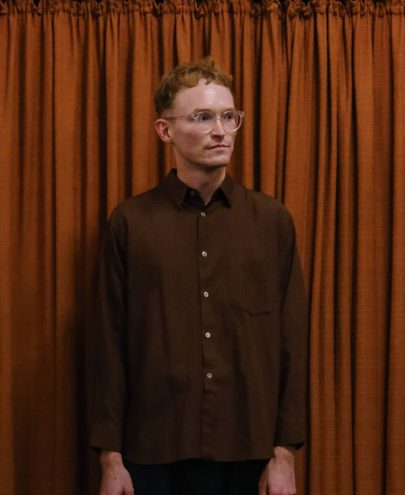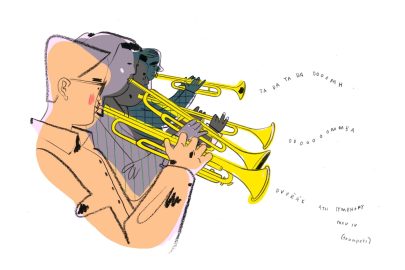Oct 7, 2013 Music
New Zealand Opera
ASB Theatre Aotea Centre
October 5, 2013
When you really hear the music, you don’t hear the music at all. Sorry, too zen? It’s Wagner’s fault.
Or rather, it’s NZ Opera’s fault. Or in fact, it’s the fault of everyone involved in the NZ Opera/Opera Queensland co-production of The Flying Dutchman. I will be mentioning several of these people shortly, but to the entire collective – director, conductor, designer, cast, orchestra, crew, administrative staff, the Auckland phone directory’s worth of necessary professionals who put this thing together and whose sheer numbers make a full staging of any Wagner opera such a high risk venture – congratulations. I do not believe there is such a thing as the perfect Wagner production – there are too many factors to balance, too many inevitable compromises – but there are bad ones, competent ones, good ones, and great ones, and this one is good verging on great. It gets a few things wrong, but it takes the right risks, and it has the right soloists for every single role, and the chorus and orchestra knock it out of the park. It took me to a place where I stopped being aware that I was hearing the music, and that is very hard to do.
The legend of the Flying Dutchman seems to date back to 17th century naval warfare between the Dutch and the English, and specifically to the English perception that the Dutch were sailing certain routes faster than was humanly possibly. They must be getting help: Satanic help, the English could only assume. By Wagner’s time, the various forms this story assumed over the centuries had solidified into that of a Dutch captain, cursed by the devil to sail endlessly until the day of judgement. Unless he could find redemption through the love of a woman “steadfast unto death”, which he was free to leave the sea to seek, but only once every seven years.
There are links between this story and the emerging nineteenth century genre of vampire fiction, and this is a useful thing to know, because in Wagner’s telling it has many of the hallmarks of nineteenth century Gothic horror: on the one hand a dark immortal creature looking for a sacrificial victim, and on the other, a pure-souled woman whose willingness to sacrifice herself is presented as a Christ-like, possibly redemptive offering. The mix of religious mysticism and ghoulishness is distinctly pre-modern, and when you add in the solid merchant-sailor dad who’s thrilled to marry his daughter off to a chance-met stranger in exchange for money, and the whiny stalker of a boyfriend for whom Wagner seems to expect us to feel sympathy, you end up with a story in which there is no obvious place to plant your feet.
Director Matthew Lutton and designer Zoë Atkinson, having perhaps decided that a naturalistic staging of this particular opera will tend to be perceived as an uninvolving Gothic curiosity, have opted instead for abstraction. The first act curtain rises on a white-cloth wasteland littered with over-turned wooden dining chairs. To the right of the stage is a packing crate the size of a small room, its two leading walls missing so we can see into it. It’s full of exhausted-looking sailors. It is, in fact, a ship, lately blown back out to sea after nearly reaching safe harbour at what was to be the end of a long voyage.
So, that white cloth covering the stage would be the sea, then, and those chairs would be – hmm. Symbolic of something. Presumably. I had real problems with those chairs. But the staging is dramatic, and becomes more so. Midway through act one, while the worn-out sailors sleep, a vast wall looms into view at the rear of the stage and advances towards the ship. They’re being blown onto a rock! Well, no, it’s another ship, a huge, terrible, dark ship; I am embarrassed to admit how long it took me to work this out. The rear walls of the packing-case ship abruptly glow a bright fluorescent white, and a dark-cloaked figure steps out into view, walking on the surface of the ocean, pausing occasionally to grasp the back of one of the chairs and sing about the many down-sides of immortality.
The dark-cloaked figure is the Dutchman, splendidly well sung by Jason Howard. His lament crests to what ought to be a grand romantic climax, and hangs on the air a long moment as he stands frozen, seeming to realise that musically this should be a moment of catharsis, and yet he isn’t feeling any. Then the final words of the lament – “Eternal oblivion take me” – come ghosting faintly back from a male chorus off-stage. It’s a magnificent moment, perfectly performed, and it was the moment when I started to feel that the staging – strange, alienating and yet so vivid – was expressing something intrinsic to the music.
The oceanic chairs of gloom remained a distraction.
The second act at first seems far less surreal. Beautiful, sprightly singing from an all-female chorus balances the all-male voices of the first act, and builds towards the meeting of the Dutchman and Senta (Irish soprano Orla Boylan), the woman he hopes will break his curse. Their duet is affecting and even – not a word I generally associate with Wagner – erotic, and rises to a moment of sudden ghastly horror. The lulling normality of the stage set turns out to have been a cunning ploy. But it’s in the third act that the full power of this staging becomes apparent, with the full chorus, massed male and female voices together for the first time, singing a grand comic invitation to the Dutchman’s silent, motionless crew to join in their drinking games.
The surging force of the music when the undead crew finally rise to their feet and advance on the living will remain in my memory as one of the great aesthetic experiences I have had this year, and a large part of the reason is the way it was staged. For two or three minutes, I was fully in the opera, by which I mean I was not thinking about it, and not aware of the music as something separate from what I was seeing on stage. It was expressing what I was feeling. Which was a riotous mix of awe, dark humour, and alarm. The stark visual minimalism of this production ultimately allows it to drink in the power of great singing and orchestral playing, and grip you by the spinal column.
I love the ambiguous twist they’ve given the ending. I shall not spoil it. It involves, I could not help noticing, a chair.
Until October 12.
Photographed by Neil Mackenzie.





